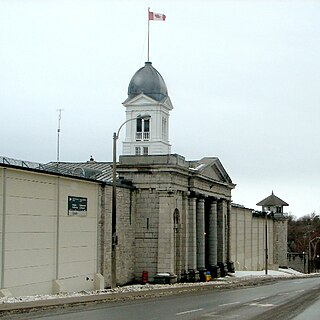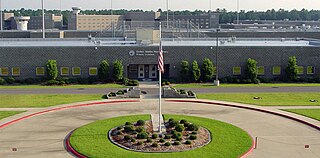Related Research Articles

Bank robbery is the criminal act of stealing from a bank, specifically while bank employees and customers are subjected to force, violence, or a threat of violence. This refers to robbery of a bank branch or teller, as opposed to other bank-owned property, such as a train, armored car, or (historically) stagecoach. It is a federal crime in the United States.

Kingston Penitentiary is a former maximum security prison located in Kingston, Ontario, Canada, between King Street West and Lake Ontario.

The Don Jail was a jail in Toronto, Ontario, Canada, located to the east of the Don River, on Gerrard Street East in the Riverdale neighbourhood. The original building was completed in 1864 and was reopened in 2013 to serve as the administrative wing of Bridgepoint Active Healthcare, a rehabilitation hospital located adjacent to the jail. Prior to its adaptive reuse as part of a healthcare facility, the building was used as a provincial jail for remanded offenders and was officially known as the Toronto Jail. The jail originally had a capacity of 184 inmates, and it was separated into an east wing for the men and a west wing for the women.

Edwin Alonzo Boyd was a Canadian bank robber and leader of the Boyd Gang. His career made him a notorious Canadian folk hero.
Egan's Rats was an American organized crime gang that exercised considerable power in St. Louis, Missouri, from 1890 to 1924. Its 35 years of criminal activity included bootlegging, labor slugging, voter intimidation, armed robbery, and murder. Although predominantly Irish-American, Egan's Rats did include a few Italian-Americans and some Jewish immigrants, most notably Max "Big Maxie" Greenberg.

William P. "Dint" Colbeck was a St. Louis politician and organized crime figure involved in bootlegging and illegal gambling. He succeeded William Egan as head of the Egan's Rats bootlegging gang in the early 1920s.
Ang Soon Tong is a secret society based in Singapore and Malaysia. According to a former police officer, the society was active as early as the 1950s, mainly in the Sembawang area. In 1998, a 19-year-old youth was arrested for setting up a website dedicated to the society.

Reuben Houston Burrow was a train-robber and outlaw in the Southern and Southwestern United States. During the final years of the American frontier, he became one of the most infamous and hunted men in the Old West since Jesse James. From 1886 to 1890, he and his gang robbed express trains in Alabama, Arkansas, Louisiana, the Indian Territory and Texas while pursued by hundreds of lawmen throughout the southern half of the United States, including the Pinkerton National Detective Agency.
The Reno Gang, also known as the Reno Brothers Gang and The Jackson Thieves, were a group of criminals that operated in the Midwestern United States during and just after the American Civil War. Though short-lived, the gang carried out the first three peacetime train robberies in U.S. history. Most of the stolen money was never recovered.

The United States Penitentiary, Pollock is a high-security United States federal prison for male inmates in unincorporated Grant Parish, Louisiana. It is part of the Pollock Federal Correctional Complex and operated by the Federal Bureau of Prisons, a division of the United States Department of Justice. The facility also has an adjacent satellite prison camp for minimum-security male offenders.

John Allen Kendrick was an American criminal, escape artist, bank robber and member of the Tri-State Gang whose career spanned four decades. He was listed on the FBI's Top Ten Most Wanted in late 1955, and was apprehended by the FBI that same year.

Citizen Gangster is a 2011 Canadian biographical drama film directed and written by Nathan Morlando. Scott Speedman stars as Canadian gangster and alleged murderer Edwin Alonzo Boyd.
North Preston's Finest, also known as NPF, the Scotians, or the North Preston gang, is a gang of pimps based in North Preston, a satellite of Dartmouth, Nova Scotia, Canada.

Brian Michael Vallée (1940–2011) was a Canadian author, journalist, documentary film producer, screenwriter, and public speaker. He is best known for his work reflecting on domestic violence and his role with CBC's award-winning documentary program The Fifth Estate. His first non-fiction book, Life With Billy focused on the life of Jane Hurshman, an abused wife whose legal case resulted in battered wife syndrome becoming a legal defense in Canadian courts.

Edwin Alonzo Boyd: The Story of the Notorious Boyd Gang is a non-fiction book written by Brian Vallée. It was published in 1997 by Doubleday Canada. This work revolves around the life of notorious Canadian bank robber Edwin Alonzo Boyd and his role in the Boyd Gang. Vallée worked closed with Boyd in the writing of this book and spent considerable time interviewing Boyd about his memories of his criminal career.

Taymor Travon McIntyre, better known professionally as Tay-K, is an American rapper and convicted murderer. He is best known for his 2017 song "The Race", which peaked at number 44 on the US Billboard Hot 100 and received platinum certification by the Recording Industry Association of America (RIAA). Its lyrics detailed criminal activity carried out by McIntyre, and became popular following a nationwide manhunt for his eventual arrest in Elizabeth, New Jersey.

Punch Coomaraswamy was a Singaporean judge, diplomat and politician who served as Speaker of the Parliament of Singapore between 1966 and 1970, and Singapore Ambassador to the United States between 1976 and 1984.
Serge Quesnel is a Canadian gangster best known for his work as a hitman for the Hells Angels Motorcycle Club. Quesnel turned Crown's evidence in 1995 and testified against several Hells Angels members in exchange for a lesser sentence in five contract killings he performed for the club.
Richard Vallée is a Canadian outlaw biker and gangster. A drug trafficker and member of the Hells Angels Motorcycle Club, Vallée was extradited to the United States and sentenced to life imprisonment in 2007 for the 1993 car bomb murder of New York State Police drug informant Lee Carter.
Frederick Joseph McMahon was a provincial court judge in Ontario who had previously been a lawyer and reeve of North York, Ontario from 1953 to 1955. As a lawyer, McMahon was well known for having defended bank robbers Edwin Alonzo Boyd and his brother Norman in their 1952 trials.
References
- 1 2 3 4 5 6 7 8 9 10 Toronto's Infamous "Boyd Gang", CBC Archives
- ↑ Brian Vallee (2011). Edwin Alonzo Boyd: The Story of the Notorious Boyd Gang. Doubleday Canada. ISBN 978-0-385-25827-2.
- ↑ "8 daring Canadian prisoner escapes" . Retrieved 5 September 2015.
- ↑ Goldenberg, Susan (20 September 2018). "Opinion | Where was Boyd Gang in September 1952? Hiding in North York, as it turns out". Toronto.com. Retrieved 5 June 2020.